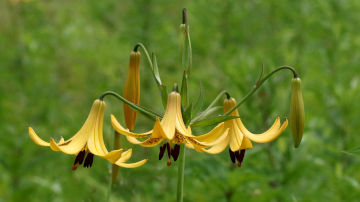Village News

PHOTO COURTESY OF GARRY KESSLER
Canada lily blossoms
July 16, 2021
NATURE NOTES
By Annie Reid
Westborough Community Land Trust
Wild Canada lily
Have you ever seen a beautiful lily in the wild? We tend to think of lilies as garden plants that beautify our yards in July, but native wild lilies, such as Canada lily, can be special – and increasingly rare - treats in our local natural environment.
If you walk trails in moist places - near streams, wet meadows, or woodland edges - you might catch sight of large, downward-facing bell-like blossoms that seem to float in the air amid the surrounding foliage. They could be yellow or orange on the outside, and spotted inside. You've found a Canada lily (Lilium canadense), also called wild yellow-lily or meadow lily. Its blossoms usually last for several days, unlike daylily flowers.
And better yet, you've found it before our abundant white-tailed deer have gotten to it. For deer, the blossoms make a tasty mouthful. People are sometimes disappointed to recognize the plant with its 1-4-foot straight stem and whorls of dark green, lance-shaped leaves - but with the buds or blossoms nipped off.
Deer aren't the only creatures who consume lilies. Throughout history, humans have eaten various lily species. Lily buds might even be an ingredient in your favorite Chinese hot-and-sour soup.
The buds, flowers, seeds, and root (bulb) of Canada lily are all edible and were gathered as food by Native Americans. The bulb is said to have a peppery taste. Today, people who forage for wild foods might consider boiling Canada lily bulbs as a vegetable, but only if they find the plant in great abundance.
Native Americans also had medicinal uses for tea made from the root of Canada lily, treating stomach problems and rheumatism with it. They used the root in a poultice applied to snakebites.
What about pollinators? If you watch Canada lily blossoms for a while, you might see some of the action. Besides bees, ruby-throated hummingbirds are important pollinators of Canada lily. With their long beaks and ability to hover and to fly both forward and backward, these tiny birds have no problem getting the nectar deep in the nodding flowers and transferring pollen in the process. Large butterflies have trouble dealing with the downward-facing bells, but some, such as tiger swallowtails, are able to "steal" nectar without transferring pollen by chewing a hole in the base of the flower.
Lilies of various kinds have been popular for thousands of years, going back to ancient Egypt, ancient China, and classic Greece. Today we have fleur-de-lis motifs and traditional white Easter lilies. Lily is often chosen as a girl's name, ranking 35th on the 2021 list of 1000 girls' names (published by the social security administration). Lilies are also used to celebrate 30th wedding anniversaries.
Today's science, with gene sequencing and other techniques, has been making the terminology and classification associated with lilies more precise. The once-huge lily family (Liliaceae) is now smaller, with many former members now assigned to about 13 other families. For example, asparagus was once in the lily family, but is now in the asparagus family (Asparagaceae). Daylilies are now in their own family, the hemerocallis family (Hemerocallidaceae).
Our native Canada lily remains in the lily family (Liliaceae). In our area, you might also see its closest wild relatives. They include the native wood lily (Lilium philadelphicum), with upturned red-orange blossoms that attract butterflies in fields. There's Turk's-cap lily (Lilium superbum), native but also grown as a garden plant. Lance-leaved tiger lily (Lilium lancifolium), native to China, is a garden plant that sometimes escapes to the wild. Enjoy!